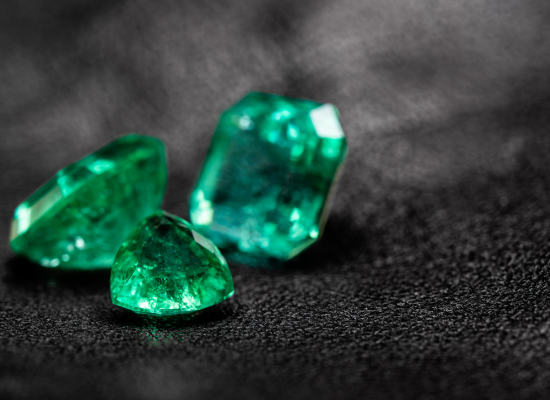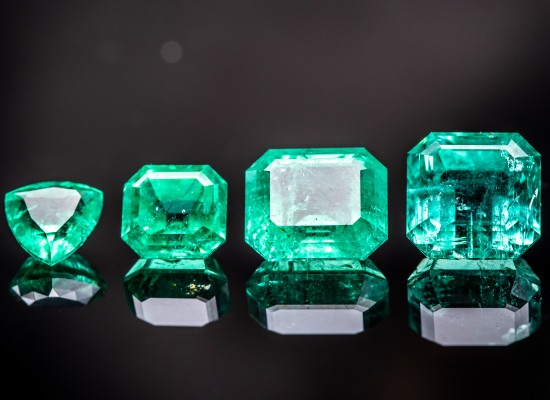This article revolves around Colombia, the source of the world’s finest emeralds. The other emeralds you are likely to see are from other sources in Brazil, Africa and Asia. In terms of weight, Brazil produces the most emeralds. Measured in value, however, Colombia is the largest producer, followed by Zambia, Brazil, the Swat Valley area between Pakistan and Afghanistan, and Russia. This chapter introduces you to these other major sources and concludes with an update on Colombian emerald mine production.
Brazilian Emerald
The Brazilian emerald’s consistent availability at affordable prices has made it popular the world over. A large Brazilian gem cutting industry was in place even before emeralds were discovered at Salininha, in the state of Bahia, in 1963.
When Brazilian emeralds came into the market in quantity, their cutting followed the same systematic pattern successfully used with citrine, topaz, tourmaline and other colored stones. That is, the cutting of uniform shapes and sizes paved the way for emerald sales to large jewelry manufacturers.
This remains the strength of the Brazilian emerald market. Because the cutters in Colombia are more concerned with retaining weight from the rough, Colombian emeralds have unique dimensions suitable mainly for single-stone settings. While it is difficult to buy a 7 x 9 mm or an 8 x10 mm emerald in Colombia, if you ask for such an emerald in Brazil, they will reply, “How many do you need?”
Although the quality of Brazilian emeralds does not measure up to the Colombian product, the standard sizes make those stones attractive to jewelry manufacturers. Many of these manufacturers are Indians with jewelry factories not only in India but also Bangkok and Hong Kong. Israeli buyers also seek Brazilian rough for cutting.
Colombian emeralds possess the chemistry for the perfect color, but this superiority does not become evident until the size reaches about one carat. This is one of the niches in the market that Brazilian emeralds fill admirably: attractive sub-carat sizes for jewelry.
Geology
Brazilian emeralds form where there is contact between a layer of biotite schist and a mass of granite gneiss that became molten under metamorphic heat and pressure. In the state of Bahia, many localities contain emeralds that are concentrared in small pockets and veins, as was the case in Carnaiba. In other Brazilia, localities, emeralds are spread over a large area where the schist and granite gneiss touch each other, namely the large mining regions of Minas Gerais. At the successful mines in these areas, such as Belmont and Piteiras, large volumes of material are moved and washed carefully. Inspection is very important to finding the emeralds in the dark schisto. In either case, the miners follow the layers between the schist and the granite, hoping to uncover emeralds.
Zambian Emeralds
Emerald production from Zambia has risen to world status in only the last 25 years. The largest mine currently operating in Zambia’s Kafubu emerald district, Kagem mine, is highly mechanized and efficient, moving over 20,000 tons of rock per day. Kagem is owned by Pallinghurst Resources, a London based company that recently gained control over the majority of emerald mines in Zambia. Dozens of smaller claims are worked by independent groups in areas to the northwest. This is now the second most valuable emerald source in the world.
The emeralds are extracted by open-pit mining, mainly from metamorphic schist rock that runs parallel to tourmaline veins.
Zambian emeralds differ from Colombian stones in subtle ways: The refractive index and specific gravity are slightly higher, due to a higher percentage (6% vs. 2% in Colombian stones) of foreign-element content such as chromium, magnesium, vanadium, iron and sodium. While the higher iron content of Zambian emeralds extinguishes the gem’s natural fluorescence, proper cutting of these highly transparent stones adds liveliness and brilliance.
The emeralds from this area exhibit strong dichroism and may often be color zoned. Other emeralds from Zambia are lighter in color but larger and clean.
They sell in the range below $1000 per carat. When the color is even less and tending a bit towards the yellowish, they cease to look like emeralds and are sold as “chrome green bery!”.
Zambian rough is cut in India and Israel. In the 1980s and ’90s, exports peaked at nearly $100 million per year: As of 2006, Zambian emeralds accounted for nearly 20% of the world market.
Pakistan/Afghanistan Emeralds
The historic Swat Valley emerald localities include the Gujar Kili and the Mingora emerald mines of Pakistan. Nearby in Afghanistan, Panjshir (Five Lions) Valley emeralds are mined at Buzmal, over 12,000 feet in altitude.
High altitudes and harsh weather conditions in this remote area limit mining to the summer months. As mentioned in Chapter 13, oxygen isotope analysis has proved that Swat Valley emeralds were traded along the Silk Road centuries before these mines there were officially “discovered” in the 1950s. The Silk Road, a crossroads for ancient Indian, Persian, European and Chinese trade routes, has connected this region to the rest of the world for thousands of years. These same routes were the paths of conquests for Alexander the Great and the Mughal raids that led to the conquest of India.
The Afghani/ Pakistani localities have a contemporary history that is almost as interesting. Russian occupation, Taliban control and civil war have not stopped the locals trom mining emeralds in the various tunnels. When dynamite was unavailable, landmine detonators and bombs were adapted for use.
Starting in the 1980s, American gem dealer Gary Bowersox began working with different international teams of geologists and gemologists to help train the Afghani locals on mining and marketing methods.
While his efforts were twice interrupted by war, Bowersox has been invited to return by a U.N. development group.
Although some of the finer material from this area is comparable to the bright, saturated color of Colombian emeralds, production has not yet grown to a significant share of the world market. Much activity is underway to enable further exploitation of these naturally beautiful emeralds.
Russian Emeralds
Stone dealer Warren Boyd has been involved with Tsar Emerald and the re-implementation of the old Russian Malyshev emerald mine since 2005. He was able to supply recent information on a mine that may be quite important in the future. Located in the Ural mountains in Sverdlovsk (now Ekaterinburg) region of Central Russia, the Tsar Emerald company has needed significant money and time to rehabilitate the mining operation.
In 2006, the emeralds reached the surface for the first time since 1990. Selling activities and exportation proceeded with good success as numerous contracts of rough emerald (and some alexandrite) were sold on the international markets. Another portion was cut and polished in Israel and Sri Lanka, with the best stones selling at $6,000 per carat wholesale. The emeralds show a nice pink fluorescence similar to Colombian stones, and some of the lighter material has excellent life that good cutting can bring out.
It is more and more a reality in the new millennium that government permits and approval for gem mining hinge on environmental regulations. In countries like Russia where the bureaucracy can be cumbersome, legal delays can extend for years. Such was the case in 2007 when the mining company suspended operations while resolving such issues.
As with many things Russian, the scale of the activities there is larger than one would initially imagine: at the peak in 2006-7 there were over 500 workers producing from well-studied underground reserves. Its hundred-year history left an infrastructure that is deep and extensive. The tunnels encompass of over 10 km of railways and were being exploited at 350 meters below the surface. The abandoned open-pit mine on the surace (operated sporadically since the 1800s) is about 1 kilometer long, half a kilometer wide, and about 200 meters deep. In terms of infrastructure and production capacity this is one of the largest colored stone mining operations in the world.
North Carolina Emeralds
Even though it does not supply commercial quantities, North Carolina is interesting as the only U.S. source of emeralds. Emeralds have been mined in the Hiddenite district of Alexander County for over 100 years. The mining has been sporadic, and profitable operations have never been sustained for more than a few years at a time, though some finds have been spectacular.
The emeralds are found in Alpine-type quartz veins and tend to occur in isolated pockets rather than being spread out in the schists. This can mean months or years of digging interspersed by occasional rich bonanzas. In the area belonging to the North American Emerald Mines, president and CEO Jamie Hill unearthed almost 3,000 carats during two months in 1998. It will be interesting to see whether such productivity can be repeated now that Hill, in 2006, has obtained permission to move greater amounts of earth than before.
The other notable source in North Carolina is the Adams mine, also located in the Hiddenite district. Started on what was once a farm, this mine also sees sporadic private digging with occasionally rich and promising finds. This type of starve-feast cycle is similar to that of Bahia, Brazil, where emeralds are found only in pockets and veins. A miner can become a millionaire if he finds a vein, called a veio do sebo (“vein of fat”). However, it may take years to find a veio de sebo, and it is almost impossible to finance a mining operation based on such long-shot odds. In North Carolina, as in Bahia, the digging is done by passionate farmers, small groups and locals rather than large companies.
Overview of Colombian Emerald Production
As of late 2008, the Colombian mines are in their second year of “jackpot” production of fine emeralds. The total exports of emeralds per year has, for three years in a row, exceeded the previous year by over 50%; hence the word jackpot. Bonanza, however, is a word reserved for the 100% La Pita mine in 1999-2002.
Inexplicably, in late 2007 Muzo and La Pita (15 kilometers apart) both started to produce quantities of rich, dark, highly saturated emeralds; a geologic coincidence considering their distance from each other and their different tunnel configurations. At first the material was too dark, but within a w months transparency increased and texture impr ed to the extent that no one remembered anything fine. Emeralds in the ten, fifteen and even twenty thousand dollar per-carat price range were being seen. World demand has been strong enough to consume these expensive quantities, only slowing down with the onset of the global financial crisis in late 2008.
The mine owners are working well together, and cooperating with government agencies and the exporters associations. FEDESMERALDAS, the umbrella organization that encompasses the exporters association, the mine owners group and the brokers association, has a new president and board. They are seeking to improve the name-recognition of Colombian emerald worldwide and moving in the direction of applying Fair Trade principles in production and marketing. Bolstering these efforts is a new laboratory, the CDTEC, which will add a reliable scientific basis to understanding and marketing the Colombian product.

Source: Ronald Ringsrud – Emeralds A Passionate Guide

